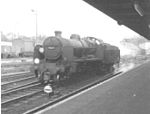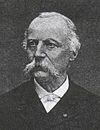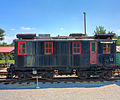Portal:Trains
Portals → Technology → Transport → Trains
The trains portal
|
In rail transport, a train is a vehicle or (more frequently) a string of vehicles capable of being moved along a continuous line of rails or other guideway for the purpose of conveying freight or passengers between points on a predetermined route. The train may be hauled or propelled by one or more vehicles designed exclusively for that purpose (locomotives) or may be driven by a number of motors incorporated in all or several of the vehicles (multiple units). As of 2018[update], there are approximately 1,052,000 kilometres (654,000 mi) of railway track in use worldwide. (World Bank (via Archive.org)) |
|
Selected article of the week
The SR U Class were 2-6-0 mogul steam locomotives designed by Richard Maunsell for passenger duties on the Southern Railway in Great Britain. They were to be used on cross-country and semi-fast expresses. A highly standardised class of locomotive, the U Class project was given greater emphasis after the Sevenoaks railway accident which involved another class of locomotive, Harry Wainwright's SECR K Class 2-6-4T. Several members of the U Class were rebuilds of the K Class at the Ashford railway works, and were soon granted the nickname 'U-Boats.' The U Class was a reliable and economical design, and proved to be more than capable of attaining speeds in excess of 70 mph (110 km/h). Able to operate over most of the Southern Railway network after grouping in 1923, the U Class survived until 1966, when all had been withdrawn from service. Four examples have been preserved, two at the Bluebell Railway, and two others at the Mid-Hants Railway.
Recently selected: Pennsylvania Station (New York City) - Chemin de fer des Côtes-du-Nord - Victorian Railways A2 class
Selected image of the week
Chicago and North Western Railway towerman R. W. Mayberry operates the retarders at Proviso Yard in Chicago, Illinois, May 1943.
Hump yards are the largest and most effective classification yards with the largest shunting capacity. The heart of these yards is the hump: a lead track on a hill (hump) over which the cars are pushed by the engine. Single cars, or some coupled cars in a block, are uncoupled just before or at the crest of the hump and roll by gravity into their destination tracks in the classification bowl (the tracks where the cars are sorted). They are slowed in their descent by retarders that grip the wheels of passing cars to slow them by friction.
Recently selected: West Coast Wilderness Railway - Copenhagen Metro tunnel - Wheelset stockpile
Did you know...
- ...that the opening ceremonies of the Galway to Clifden railway were very sparsely attended because the event date was a strict church holiday and was reserved for attending church services?
- ...that following heavy damage to the Galveston Island Trolley track and cars from Hurricane Ike in 2008, substitute service with replica buses was operated until service resumed in October 2021?
- ...that although the former Santa Fe Railway's Galesburg station was demolished after regular passenger service to the station ended in 1996, the site is still used if derailments cause trains to use the Chillicothe Subdivision instead of the Mendota Subdivision?
- ...that the Fuzhou–Xiamen railway, which opened in 2010, was so heavily used that it reached capacity in 2015, spurring construction on the parallel Fuzhou–Xiamen high-speed railway for CRH passenger train services?
Selected anniversaries
- September 20
- 1820 – Alfred Belpaire (pictured), inventor of the Belpaire firebox used on steam locomotives, is born (d. 1893).
- 1853 – Indianapolis's Union Station, the first union station in the United States, opens.
- 1873 – In order to contain the Panic of 1873, brought on by the failure of Jay Cooke & Company in financing the Northern Pacific Railway, the New York Stock Exchange halts all trading and closes for ten days.
- 1997 – RaiLink Southern Ontario begins operations on the former Canadian National Railway Hagersville subdivision between Nanticoke and Brantford.
Train News
- July 24, 2021 – Atchison, Topeka and Santa Fe No. 2926, a 4-8-4 steam locomotive built by Baldwin Locomotive Works in 1944, moves under its own power for the first time since Christmas Eve of 1953, after nearly twenty-two years of being rebuilt by volunteers. The locomotive will be put into mainline excursion service. (NMSL&RHS, Trains Magazine on Facebook)
- May 5, 2021 – Steamtown National Historic Site completes thorough cosmetic overhaul on Union Pacific 4-8-8-4 Big Boy No. 4012, which is moved back on static display before National Train Day. (NEPA Scene)
- April 2, 2021 – 2021 Hualien train derailment – A Taroko Express train operated by the Taiwan Railways Administration (TRA) derails at the north entrance of Qingshui Tunnel in Heren Section, Xiulin Township, Hualien County, Taiwan, killing 49 people and injuring at least 200 others. North of Hualien City a construction truck had fallen down a slope onto the tracks. The eight-carriage train derailed after colliding with the truck, and then came to a rest in the tunnel, with severe damage and many casualties. (Bloomberg, CNN, CNA, New York Times, Financial Times)
- December 31, 2020 – Following a complete restoration, Chesapeake and Ohio 1309, a 2-6-6-2 Mallet locomotive built by Baldwin Locomotive Works in 1949, the last steam locomotive built by Baldwin for the North American market, is operated under its own power for test runs. When returned to service on the Western Maryland Scenic Railroad, it will be the largest steam locomotive in regular scheduled service in the United States and take 2-8-0 No. 734’s place as the largest active steam locomotive in the state of Maryland. (Trains.com Newswire)
- September 28, 2020 – Amtrak operates a test run using one of the 28 new Avelia Liberty trains manufactured by Alstom along the full length of the Northeast Corridor to Boston South Station. Previous test runs had occurred from Washington, D.C., only as far north as New Jersey and Delaware. Barring any problems, the trains are expected to enter regular service on the route in 2021. (Universal Hub)
- June 13, 2020 – The Bay Area Rapid Transit Silicon Valley BART extension opened its stations in Milpitas and North San Jose. (San Jose Spotlight, SF Gate)
General images
WikiProjects
WikiProject Trains (Shortcut: WP:TWP)
- WikiProject Stations (WP:STA)
- WikiProject Streetcars (WP:TRAM)
- WikiProject Rapid transit (WP:RTPJ) inactive
- By region:
- WikiProject Metros of the former Soviet Union (WP:SOVMETRO) inactive
- WikiProject Indian railways (WP:INRW)
- WikiProject Trains in Japan (WP:TJ)
- WikiProject New Zealand Railways (WP:NZR)
- WikiProject Pakistan Railways (WP:PKR) inactive
- United Kingdom
- United States
- Fictional rail transport topics:
Note: WikiProjects marked as inactive are retained pending future editing activity
Subcategories
Things you can do
See also Wikipedia:WikiProject Trains/Todo and Wikipedia:Pages needing attention/Railroads
Associated Wikimedia
The following Wikimedia Foundation sister projects provide more on this subject:
-
Commons
Free media repository -
Wikibooks
Free textbooks and manuals -
Wikidata
Free knowledge base -
Wikinews
Free-content news -
Wikiquote
Collection of quotations -
Wikisource
Free-content library -
Wikiversity
Free learning tools -
Wiktionary
Dictionary and thesaurus
























































































